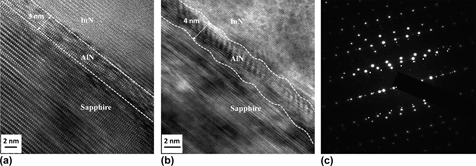Article contents
Epitaxial growth and interfaces of high-quality InN films grown on nitrided sapphire substrates
Published online by Cambridge University Press: 16 April 2013
Abstract

InN films have been grown on sapphire substrates nitrided by N plasma with different durations by radio-frequency plasma assisted molecular beam epitaxy (RF-MBE). In-depth investigation reveals that AlN is generated on a sapphire surface during the nitridation, and 60 min nitridation helps in the formation of an ordered and flat AlN interlayer between the substrate and the InN film, which improves the surface migration of In atoms on the substrate, and consequently helps in obtaining a single-crystalline c-plane InN film of high quality with 1.0 × 1019 cm−3 carrier density and 1350 cm2/(V·s) carrier mobility. Too short nitridation duration will result in a polycrystalline InN film, and too long nitridation duration will damage the surface quality of the newly generated AlN interlayer which consequently deteriorates the InN film quality. Control of the AlN interlayer quality plays a critical role in the growth of a high-quality InN epitaxial film on the sapphire substrate.
- Type
- Articles
- Information
- Copyright
- Copyright © Materials Research Society 2013
References
REFERENCES
- 8
- Cited by


